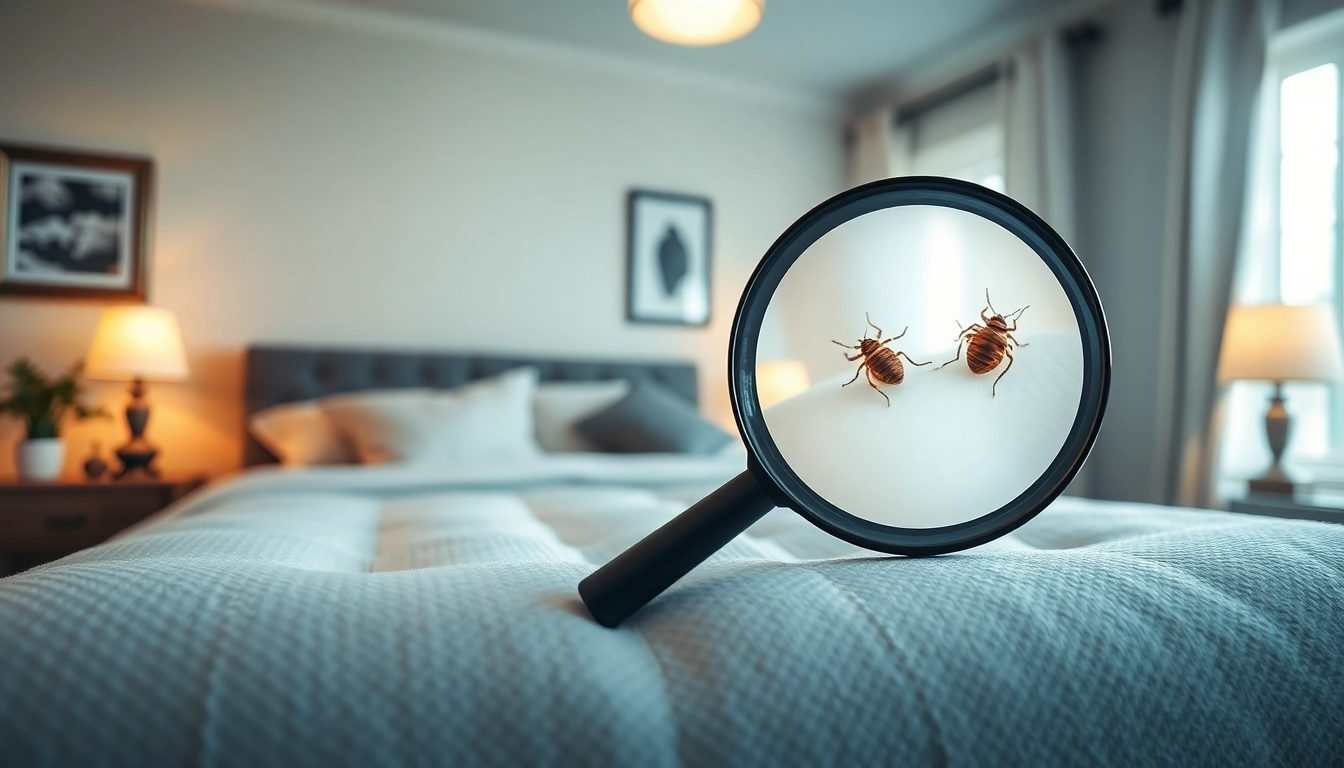Understanding Bed Bugs: Nature and Behavior
What are Bed Bugs?
Bed bugs are small, nocturnal insects belonging to the Cimicidae family. They primarily feed on the blood of humans and animals, making them a parasitic pest. Adult bed bugs are about the size of an apple seed, measuring approximately 4-5 mm in length and can be recognized by their flat, reddish-brown bodies. In their immature stages, they appear as tiny, light-colored nymphs. Despite their small size, bed bugs have a significant impact on health and well-being, as their bites can lead to itching, allergic reactions, and insomnia.
How Bed Bugs Spread
Bed bugs are expert travelers, often hitching a ride on clothing, luggage, and used furniture. They can move between rooms in multi-unit residences, such as apartments or hotels, making it challenging to contain an infestation. They are not restricted to dirty or unsanitary environments; they’ve been found in pristine hotels and even high-end residences. Understanding their habits is crucial for prevention and efficient bed bug removal. They reproduce quickly, and a single fertile female can lay hundreds of eggs, which adds to the difficulty of eradicating them once established.
Signs of an Infestation
Recognizing the early signs of a bed bug infestation can save you from a more serious problem later. Common signs include:
- Visible Bed Bugs: Look for live or dead adults, nymphs, or eggs in bed linens, mattresses, and cracks in furniture.
- Bed Bug Bites: Small, red, itchy welts on the skin, often in clusters or lines.
- Blood Stains: Small reddish-brown spots on bedding, which can be blood from crushed bed bugs.
- Fecal Spots: Tiny, dark dots (bed bug droppings) on surfaces where they’re hiding.
- Molted Skins: Shed skins left behind as they grow and molt.
Bed Bug Removal Strategies: DIY vs. Professional Services
Effective DIY Bed Bug Removal Techniques
While professional extermination is often recommended, particularly for severe infestations, several effective DIY techniques can help manage or eliminate smaller problems. These may include:
- Heat Treatment: Bed bugs are vulnerable to high temperatures. Wash all bedding and clothing in hot water and dry them on the highest heat setting. This method kills all life stages of bed bugs.
- Vacuuming: Use a strong vacuum cleaner with a HEPA filter to remove bed bugs and their eggs from furniture, carpets, and other surfaces. Be sure to empty the vacuum bag immediately after use to prevent re-infestation.
- Steam Cleaning: A steam cleaner can effectively kill bed bugs hiding in your mattress, carpets, and upholstery. Ensure to use steam at a temperature of at least 130°F (54°C).
- Diatomaceous Earth: This natural powder can be sprinkled in areas where bed bugs hide. It works by dehydrating them when they come into contact with it.
When to Call Professional Exterminators
It is advisable to seek professional pest control services if:
- The infestation is widespread and cannot be managed with DIY methods.
- You are unsure about correctly identifying all the areas of infestation.
- Allergy or health issues arise from bites, necessitating quick removal.
- You are unable to dedicate the time and effort required for effective DIY treatments.
Professionals are equipped with advanced tools and methods that are more effective for extensive infestations and can often provide long-term solutions.
Cost Comparisons for Bed Bug Treatments
The cost of bed bug treatments can vary widely based on the severity of the infestation, the type of treatment used, and your location. Here are some general insights:
- DIY Methods: Initial costs can be low, with vacuum cleaners, steamers or diatomaceous earth costing between $50 and $150.
- Professional Extermination: Costs can range from $300 to $1500 depending on the size of the property and extent of infestation. Heat treatments tend to be on the higher end of the scale due to equipment and labor costs.
- Follow-Up Treatments: Many professional services require a follow-up treatment, which adds to the overall expense.
Investing in professional extermination might seem expensive, but compared to the potential costs of replacing infested furniture or dealing with health issues, it can prove to be a cost-effective solution in the long run.
Preparation for Bed Bug Treatment
Steps to Prepare Your Home
Preparing your home for bed bug treatment increases the chances of successful eradication. Consider these steps:
- Declutter: Remove unnecessary items and clutter which can hide bed bugs and hinder treatment.
- Wash and Bag: Wash all bedding, clothes, and fabrics in hot water and seal them in plastic bags before treatment.
- Move Furniture: Relocate furniture away from walls to allow access for treatment.
- Inform the Exterminator: Discuss any areas where you have noticed bed bugs and any previous treatments that have been attempted.
Items to Dispose of or Clean
During the preparation phase, consider which items may be infested and require disposal or thorough cleaning:
- Mattresses and Box Springs: If heavily infested, these may need to be disposed of to ensure complete eradication.
- Upholstered Furniture: Inspect thoroughly for signs of infestation. Heat treatment may be an option for cleaning.
- Clothing and Fabrics: Items that cannot be washed should be dry cleaned as high temperatures in washing are necessary to kill bed bugs.
Safety Precautions During Removal
Safety is a critical consideration during bed bug removal processes. Ensure to:
- Wear protective clothing, including gloves and a face mask, when handling infested items.
- Keep children and pets away from treated areas until it’s deemed safe by professionals.
- Follow all instructions provided by extermination professionals regarding usage of pesticides or heat treatment.
Long-Term Prevention of Bed Bugs
Best Practices to Avoid Infestation
Preventing a re-infestation of bed bugs involves consistent effort and effective practices:
- Regular Inspections: Routinely inspect bedding, luggage, and furniture for signs of bed bugs, especially after travel.
- Protective Covers: Use mattress and box spring encasements specifically designed to trap bed bugs.
- Vacuum Regularly: Make it a habit to frequently vacuum your home, focusing on areas where bed bugs commonly hide such as mattresses, carpets, and upholstery.
Regular Maintenance Tips
In addition to inspections, maintenance of your living space can significantly reduce the risk of reinfestation:
- Avoid Second-Hand Items: Be cautious when purchasing used furniture or clothing. Inspect them thoroughly for signs of bed bugs.
- Seal Cracks and Crevices: Regularly inspect and seal any cracks and crevices in walls and furniture that could serve as hiding spots.
- Educate Household Members: Provide training and information on identifying bed bugs and knowing how to respond.
Educating Your Family about Bed Bugs
Creating awareness among family members, especially children, can significantly help in early detection and prevention of bed bugs:
- Understanding Bed Bugs: Explain what bed bugs are and how they can travel. This knowledge will empower family members to respond appropriately upon witnessing signs of an infestation.
- Travel Precautions: Educate family members on inspecting hotel rooms, such as checking the seams of mattresses and using luggage stands instead of placing bags on the beds.
Resources and Support for Ongoing Issues
Finding Local Exterminators
If you continue to struggle with bed bugs despite DIY efforts, it may be time to seek help. Resources for locating a trustworthy exterminator include:
- Online Directories: Websites such as the National Pest Management Association (NPMA) offer directories of certified pest control professionals.
- Community Resources: Local health departments or university extension offices may offer assistance or referrals.
Online Communities for Support
Support can also be found through communities and forums dedicated to pest control and bed bug issues. Engaging can provide you with tips and advice from those who have experienced similar struggles:
- Reddit and Quora: These platforms often have threads dedicated to bed bug infestations where you can ask questions and receive real-life tips from others.
- Facebook Groups: Joining pest control-focused groups can connect you with local experts and community members who have successfully navigated their infestations.
Helpful Government Resources for Bed Bug Control
Various government resources can provide reliable information on managing bed bugs. For instance:
- The EPA’s Guide offers extensive guidelines on do-it-yourself bed bug control.
- Your local health department can provide information on local pest control services and health risks associated with bed bugs.



